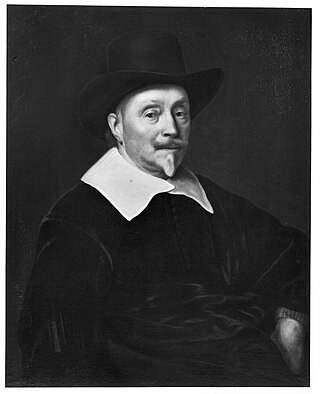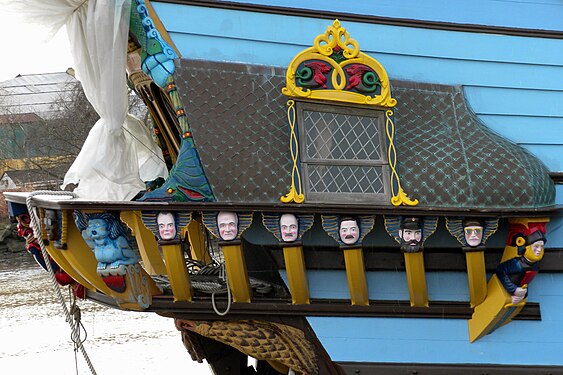
New Sweden was a colony of the Swedish Empire along the lower reaches of the Delaware River between 1638 and 1655 in present-day Delaware, Maryland, New Jersey, and Pennsylvania in the United States. Established during the Thirty Years' War when Sweden was a great power, New Sweden formed part of the Swedish efforts to colonize the Americas.

Peter Minuit was a Walloon merchant from Wesel, in present-day northwestern Germany. He was the 3rd Director of the Dutch North American colony of New Netherland from 1626 until 1631, and 3rd Governor of New Netherland. He founded the Swedish colony of New Sweden on the Delaware Peninsula in 1638.

Samuel Blommaert was a Flemish/Dutch merchant and director of the Dutch West India Company from 1622 to 1629 and again from 1636 to 1642. In the latter period, he was a paid commissioner of Sweden in the Netherlands and he played a dubious but key role in Peter Minuit's expedition that led to the Swedish colonizing of New Sweden. For years Blommaert was involved in the copper trade and industry. In 1645 he was appointed for a third time as a manager of the WIC, being one of the main investors from the beginning.

Fort Christina was the first Swedish settlement in North America and the principal settlement of the New Sweden colony. Built in 1638 and named after Queen Christina of Sweden, it was located approximately 1 mi (1.6 km) east of the present-day downtown Wilmington, Delaware, at the confluence of the Brandywine River and the Christina River, approximately 2 mi (3 km) upstream from the mouth of the Christina on the Delaware River.

The Delaware Colony, officially known as the three "Lower Counties on the Delaware", was a semiautonomous region of the proprietary Province of Pennsylvania and a de facto British colony in North America. Although not royally sanctioned, Delaware consisted of the three counties on the west bank of the Delaware River Bay. In the early 17th century, the area was inhabited by Lenape and possibly Assateague Native American Indian tribes. The first European settlers were Swedes, who established the colony of New Sweden at Fort Christina in present-day Wilmington, Delaware, in 1638. The Dutch captured the colony in 1655 and annexed it to New Netherland to the north. Great Britain subsequently took control of it from the Dutch in 1664. In 1682, William Penn, the Quaker proprietor of the Province of Pennsylvania to the north leased the three lower counties on the Delaware River from James, the Duke of York, who went on to become King James II.

The Christina River is a tributary of the Delaware River, approximately 35 miles (56 km) long, in northern Delaware. It also flows through small areas of southeastern Pennsylvania and northeastern Maryland. Near its mouth, the river flows past downtown Wilmington, Delaware, forming the city's harbor for traffic on the Delaware River. The Port of Wilmington, opened in 1923 at the river's mouth, handles international cargo and trade.
Benjamin Lees was an American composer of classical music.
Peter Hollander Ridder (1608–1692) was the governor of the Swedish colony of New Sweden from 1640 until 1643.

Swedes' Landing is the warehouse road found along the Minquas Kill in Wilmington, Delaware that is close to the Delaware River. This was the site where the initial Swedish landing took place and marks the spot where the New Sweden colony began. The first Swedish expedition to North America, under the command of Peter Minuit, embarked from the port of Gothenburg in late 1637. The members of the expedition, aboard the ships Fogel Grip and Kalmar Nyckel, sailed into Delaware Bay, which lay within the territory claimed by the Dutch West India Company and anchored at a rocky point on Swedes' Landing on March 29, 1638. They built a fort on the site which they named Fort Christina after Queen Christina of Sweden. Today Swedes Landing Road is a short stretch from 4th Street to 7th Street and ends at a long two-story mural depicting the area from the time before the Swedes came through the modern Wilmington waterfront. At the far end of the mural is the entrance to Fort Christina National Historical Site, a part of the First State National Historical Park System.
The history of Delaware as a political entity dates back to the early colonization of North America by European settlers. Delaware is made up of three counties established in 1638, before the time of William Penn. Each county had its own settlement history. The state's early colonists tended to identify more closely with their county than Delaware as a whole. Large parts of southern and western Delaware were thought to have been in Maryland until 1767. The state has existed in the wide economic and political circle of the nearby Pennsylvanian city of Philadelphia.
Reorus Torkillus (1608–1643) was priest of the Church of Sweden and the first Lutheran clergyman to settle in what would become the United States.
Måns Nilsson Kling or Mauno Kling was the second governor of the 17th century colony of New Sweden, which he administrated from Fort Christina, now Wilmington, Delaware, United States.

Fort Beversreede was a Dutch-built palisaded factorij located near the confluence of the Schuylkill River and the Delaware River. It was an outpost of the colony of New Netherland, which was centered on its capital, New Amsterdam (Manhattan), on the North River.
Sven Svensson (1636—1696) was a Justice and Legislator in Colonial Pennsylvania. He was born into a prominent family in the colony of New Sweden.

First State National Historical Park is a National Park Service unit which lies primarily in the state of Delaware but which extends partly into Pennsylvania in Chadds Ford. Initially created as First State National Monument by President Barack Obama under the Antiquities Act on March 25, 2013, the park was later redesignated as First State National Historical Park by Congress.
Fogel Grip was a Swedish sailing ship originally built in the Netherlands in the early 17th century. She was used on the first Swedish expedition in 1638 together with Kalmar Nyckel to establish the colony of New Sweden.

Events from the year 1638 in Sweden

The Delaware Tercentenary half dollar is a commemorative fifty-cent piece struck by the United States Bureau of the Mint to commemorate the 300th anniversary of the first successful European settlement in Delaware. The reverse features the Swedish ship Kalmar Nyckel, which brought early settlers to Delaware, and the obverse depicts Old Swedes Church, which has been described as being the oldest Protestant church in the United States still used as a place of worship. While the coins are dated "1936" on the obverse and the reverse also has the dual date of "1638" and "1938", the coins were actually struck in 1937.
TheFlying Deer was a 17th-century Dutch ship. She was lost at sea with all hands during a hurricane off St. Kitts in 1638.
SS Peter Minuit was a Liberty ship built in the United States during World War II. She was named after Peter Minuit, a Walloon from Tournai, in present-day Belgium. He was the 3rd Director of the Dutch North American colony of New Netherland from 1626 until 1631, and 3rd Governor of New Netherland. He founded the Swedish colony of New Sweden on the Delaware Peninsula in 1638. Minuit is generally credited with orchestrating the purchase of Manhattan Island for the Dutch from the Lenape Native Americans. Manhattan later became the site of the Dutch city of New Amsterdam, and the borough of Manhattan of modern-day New York City.

















